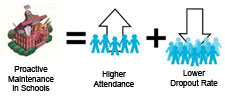Evidence from Scientific Literature about Improved Academic Performance
Schools without a major maintenance backlog have a higher average daily attendance, or ADA, by an average of 4 to 5 students per 1,000 and a lower annual dropout rate by 10 to 13 students per 1,0006.

Children in classrooms with higher outdoor air ventilation rates tend to achieve higher scores on standardized tests in math and reading than children in poorly ventilated classrooms57.


There is also evidence that modest changes in room temperature (e.g., 77°F to 68°F) affect children's abilities to perform mental tasks requiring concentration, such as addition, multiplication, and sentence comprehension. Overall, cooler temperatures and modest relative humidity conditions have the most positive impact75, 76.
On this page:
- Good Physical Conditions Can Reduce Absenteeism, Improve Test Scores and Improve Teacher Retention Rates
- Adequate Outdoor Air Ventilation Can Improve Ability to Perform, Raise Test Scores and Reduce Airborne Transmission of Infection
- Dampness and Mold Conditions Exacerbate Asthma Symptoms and Absenteeism
- HVAC Maintenance and Good Housekeeping Improve Health and Performance
- Related Resources
Good Physical Conditions Can Reduce Absenteeism, Improve Test Scores and Improve Teacher Retention Rates
- Studies that measure school conditions using an index of several variables consistently show improved scores on standardized tests as school conditions improve.55, 9, 12, 24
- On the other hand, schools with major unmet repair needs and fewer custodial workers per square foot have higher absentee rates and higher dropout rates.6
Nearly 80 percent of teachers responding to a survey in Chicago and the District of Columbia reported that school facility conditions were an important factor in teaching quality. Almost half who graded their facilities “C” or below would consider leaving. The most frequently cited problem was bad IAQ.55
Poor IAQ Causes Illness and Increases School Absenteeism
IAQ problems can cause increased absences due to respiratory infections, allergic diseases from biological contaminants, or adverse reactions to chemicals used in schools. Building factors or pollution in buildings most frequently associated with respiratory health effects include:
- Presence of moisture, water damage and microbiological pollutants.25,5
- Animal and other biological allergens.46
- Combustion byproducts7 such as nitrogen dioxide.45, 41
- Moisture or dirt in HVAC systems.33, 60
- Low ventilation rates.33, 37
- Formaldehyde.41, 44, 74, 66, 20, 19
- Chemicals in cleaning products.29, 83
- Outdoor pollutants or vehicle exhaust.22, 81, 67
Respiratory health effects, such as infections and asthma, are most closely associated with increased absenteeism.
- In 2003, children with at least one asthma attack in the previous year missed an estimated 12.8 million school days due to asthma.2
- Children’s overall performance decreases with illnesses or absences from school.11, 79, 42, 61
- Student performance also can be affected when teachers are absent due to illness.
Even the best substitute teachers may disrupt the learning process, and they can present an added expense.
Adequate Outdoor Air Ventilation Can Improve Ability to Perform, Raise Test Scores and Reduce Airborne Transmission of Infection
Ventilation rates in most schools are below recommended levels.8 Growing evidence of the positive impact of outdoor air ventilation suggests a clear opportunity for improving health and academic performance.
Ability to Perform
- Studies demonstrate a connection between improvements in IAQ — either from increased outdoor air ventilation rates or from the removal of pollution sources — and improved performance of children and adults.39, 70, 69, 31, 56, 3
- Controlled studies show that children perform school work with greater speed as ventilation rates increase.
- The performance of adults, including teachers and school staff, has also been shown to improve with higher ventilation rates.77, 78
Test Scores
Children in classrooms with higher outdoor air ventilation rates tend to achieve higher scores on standardized tests in math and reading than children in poorly ventilated classrooms.57
Transmission of Infection
Higher ventilation rates reduce the transmission and spread of infectious agents in buildings. This is the conclusion of a multidisciplinary expert panel after reviewing 40 studies conducted between 1960 and 2005.
- In their report, the authors recommend schools and similar high-density facilities increase their ventilation rates during influenza peak season.28
- In addition, a controlled study in office buildings found a link between short-term sick leave, often associated with respiratory illness, and low ventilation rates.37
- Occupants of buildings with low ventilation rates and high occupant densities experienced far higher rates of respiratory illness than did occupants of similar buildings with higher ventilation rates.56
Dampness and Mold Conditions Exacerbate Asthma Symptoms and Absenteeism
Studies show that dampness and mold in homes, offices and schools cause a significant increase in several respiratory and asthma-related health outcomes.17, 38
- Dampness and mold in homes are estimated to account for 21 percent of current asthma cases in the United States.38
School environments may account for an even higher percentage of current asthma cases.
- For schools, major risk factors include microbial concentrations in the air or in dust on floors; visible or odorous signs of mold; or dampness and mold in the building at large.10, 27, 30, 47, 49, 50, 54, 72, 71
Studies in homes, offices and schools make a strong case for programs to control moisture that produces damp and/or moldy conditions.
Temperature and Relative Humidity Control Reduce Adverse Health Symptoms
Temperatures at the warm end of the comfort zone tend to increase adverse health symptoms, while temperatures at the cool end of the comfort zone tend to reduce symptoms. Similarly, individuals perceive the quality of indoor air to be better when humidity is at the low end of the comfort zone.14, 15, 16
There also is evidence that moderate changes in room temperature (e.g., 77°F to 68°F) affect children’s abilities to perform mental tasks requiring concentration, such as addition, multiplication and sentence comprehension.75
Overall, cooler temperatures and modest relative humidity conditions have the most positive impact.76
HVAC Maintenance and Good Housekeeping Improve Health and Performance
A review of building investigation reports suggests that regular HVAC maintenance can have significant impact on health and performance.60
One study in schools and several with adult subjects also demonstrate the following:
- Airborne or surface-level dust affects health,65, 62, 21, 23 and housekeeping protocols that thoroughly remove dust from surfaces have a positive impact on health.48, 63
- Disinfection of bathroom surfaces combined with dispensers for alcohol-based hand rubs reduces absences from gastrointestinal infections.52
- Airborne particle reduction benefits health and comfort.18, 82
